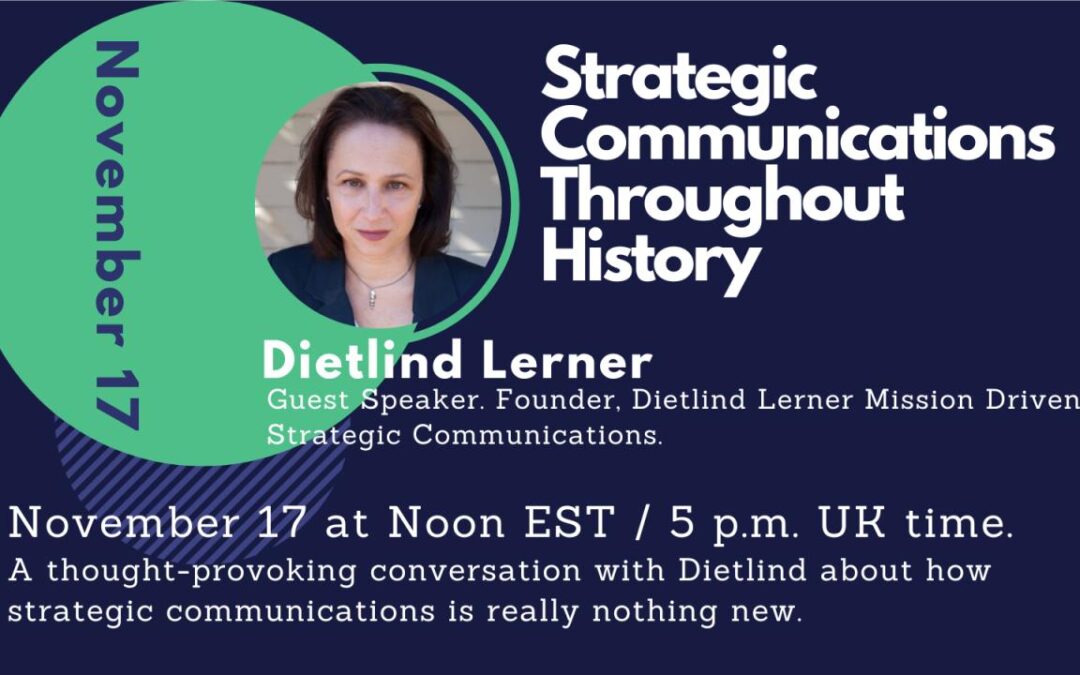Join me on Thursday on LinkedIn Live for a fascinating conversation with Dietlind Lerner. You can sign up here. I hope you join us. We’ll be talking about strategic communication throughout history. Dietlind is fluent in three languages and speaks bits of others. She doesn’t shy away from sophistication. With a degree in Art History, on the homepage of her website there’s a fresco by Abrogio Lorenzetti. Its goal was to sway people in Siena about how much nicer life is under good government than bad government. You can imagine how useful such a thing would be, adapted for today. Still, it’s not exactly lowbrow…
I’m interested to see how the conversation goes. I’m not an academic and while I do enjoy sophisticated conversation, I’m nervous I’ll be out of my depth! Those tend to be the best conversations, of course. To convince myself “I can do this,” I’ve been thinking a bit about Shakespeare, Rembrandt, Edward Hopper, and the nature of religious faith. Your usual pop culture stuff for a Wednesday.
There’s a line in Shakespeare. When King Lear is getting old, he decides to divide his kingdom amongst his three daughters. Two of his daughters flatter him with flowery speeches. It’s only his third daughter, Cordelia, who refuses. She tells him she cannot “heave my heart into my mouth.”
As a dissection of strategic communication, it’s an interesting scene. One could argue that the other two daughters are ready to dance for their supper. They don’t mind being insincere to inherit. Cordelia can’t do it. She can only be honest. She loves her dad. But isn’t interested in making a big show of it. Cue a three-hour unfolding tragedy exploring all the implications.
Cordelia is not strategic. But she is honest. Sometimes the most powerful communication is like that. It offends. It fails to consider its audience. It falls out of the mouth. She’s the hero of the moment, too. Albeit the spark in the tinderbox. It makes me reflect on whether I ever enjoy crafting words that feel too considered and delicate. Am I too much like Cordelia’s two insincere sisters?
That’s the tension that runs through my work. Is it possible to be both honest and strategic? Is there a role for creativity in balancing the two? Or does creativity sometimes mask too much compromise?
Then there’s Rembrandt. Earlier in his career, he painted amazing work bolstering the power of wealthy families. I got all this from Simon Schama’s documentary on BBC Select, by the way. I’ve not been doing deep reading on the side. By the end of his career, Rembrandt was penniless. He had devoted himself to creating “monuments of truth.” And boy, did he pay for it. Still, what lasted beyond him was the most expensive work. I mean the work he suffered for most as an artist.
I’ve walked round the Edward Hopper exhibition at The Whitney twice with my son Freddy, on recent wet days. I chuckled over the illustrations he did for trade newspapers about how best to sell life insurance. I imagine the fear and trembling they may have cost him in his studio on Washington Square, around the corner from where we live, now, in the West Village.
I’m not controlling the conversation tomorrow, and we’ll see where it goes. But one question I do want to explore with Dietlind is whether it is possible to write for money and still be honest. Or to strategically communicate for money. On a fundamental level. When you think of some of the great communicators in history, they were often on the wrong side. They were propagandists.
Meanwhile, a priest at my wife’s childhood church died recently. He wrote a fascinating piece—published after his death—about why he was an Episcopalian. I rather like it.
“Instead, I was actually encouraged to wonder and speculate about all the things I did not understand or honestly believe. My faith ended up being constructed upon a bedrock of faith–not analytical data points. The conclusions I arrived at were founded in mysteries wrapped in metaphors. They were inferences and possibilities that encouraged me to plunge deeper into faith, not fact. The irony of it all is that my faith is strong where others think it looks weak and weak where others brag about their strengths.”
Amen. And my apologies if this got too complicated. It does indeed all get a bit mysterious, life, when it comes down to it. I find the joy is in the mysteries, rather than the certainties. But if you want a blog post about how to write a press release, check out my website. I can do certainty when required.
See you for the conversation on Thursday, I hope! If you miss it, you can always watch the archived video on the sign-up page. I’m always interested to hear what you think.


